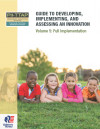Is this you?
- When the project ends, everything goes away with it.
- Even with ongoing funding, we are not getting the outcomes we want.
- Our team wants to plan for sustainability, but we don’t know where or when to start.
What is this?
When we think about sustainability, we often focus on the funding needed to keep the program going. What we really want is to maintain improved outcomes. Paying attention to sustainability involves the policy, practice, or program AND the conditions necessary to achieve those outcomes (which are described more fully in each of the Learn Implementation tabs). Sustainability planning is an essential aspect of effective implementation efforts to ensure that ongoing needs of the population and community are met.
Why is this Important?
Achieving desired outcomes involves building the implementation supports necessary to deliver an innovation. Many factors of sustainability are the same as those influencing implementation (e.g., leadership, monitoring and communicating data), so deliberate and regular attention to the process of implementation is also good practice for sustainability. Sustainability should be continuously planned for during every phase of implementation, serving as a key element to guide learning and decisions about necessary infrastructure, processes, and funding. Doing so involves:
- Implementation infrastructure and processes
Implementation supports that must be embedded into the everyday work of people and organizations to build and sustain capacity to support the “it” [practice, program, or policy being implemented]. Examples of implementation infrastructure and processes include getting and using data to understand and improve the process of implementation and development of workforce development systems that are well-aligned to the types of support needed by those who are delivering the innovation.
- Organizational infrastructure and processes
Supports at the organizational level that provide an administrative foundation for the “it” being implemented. Examples of organizational infrastructure and processes include leadership, communication feedback and feedforward loops, effective data management systems, community partnerships, and organizational culture.
- Fiscal strategies and funding sources
Funding provided for direct services and staff who will be implementing the practice, program, or policy. Examples of fiscal strategies and resources include diversified funding, personnel, and technologies.
Sustainment Resources & tools
 Guide to Developing, Implementing, and Assessing an Innovation
Guide to Developing, Implementing, and Assessing an Innovation
The Permanency Innovations Initiative Training and Technical Assistance Project team developed the Guide to Developing, Implementing, and Assessing an Innovation (the Guide) to help individuals and teams use the Development, Implementation, and Assessment Approach. Each volume of the Guide includes instructions, quizzes, real-world examples, and tools that provide guidance and support. Sustainability resources and tools can be found in Volume 5: Full Implementation in Section 10 starting on page 50.
 Plan on a Page (or Three!)
Plan on a Page (or Three!)
The Plan on a Page includes a series of questions to guide Implementation Teams to execute a goal that they have developed as a team. These questions will help teams infuse implementation best practices into the work of defining and carrying out the identified goal.
Find additional areas of implementation to help you in every stage.
